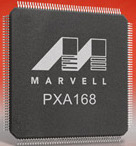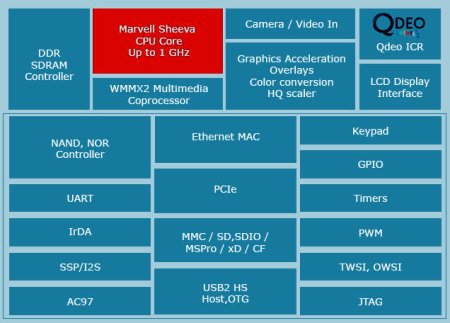ARM SoC launched with Linux support
Jan 8, 2009 — by Eric Brown — from the LinuxDevices Archive — 45 viewsMarvell is sampling a new ARM-based system-on-chip (SoC) family targeting consumer electronic devices. Based on its “Sheeva” core technology, which is said to combine Feroceon and XScale architectures, the PXA168 targets low-power devices that run Linux or Windows CE, and incorporate Internet connectivity, multimedia, and touchscreen interfaces, says Marvell.
 PXA168 |
The PXA168 is aimed at devices with low power requirements, including some low-end mobile device categories. However, it does not appear aimed at replacing the ever-popular PXA270 and newer PXA320 for high-end mobile devices such as smartphones. Target product types include digital photo frames, portable navigation devices, portable media players, home automation devices, portable TVs, digital signage, and automotive dashboard displays and infotainment systems, says Marvell.
The PXA168 is said to offer the processing capabilities of an “entry-level laptop,” on devices that still often run single-purpose real-time operating systems (RTOSes), says the company. Touted features include instant-on web surfing and widgets, multi-format video, Adobe Flash-based playback, image processing, video conferencing, and advanced graphical user interfaces (GUIs).
Sheeva unleashed
Marvell licenses the ARM architecture from ARM, Ltd., and implements its own cores, such as the “Sheeva” core used in the PXA168. Many other SoC vendors instead choose to license ready-made cores (such as ARM9, ARM11, Cortex-A8, etc.) from ARM.
Marvell's Feroceon and Sheeva cores trace their origins to Intel's XScale core, which Intel implemented based on the ARMv5 architecture (also used in ARM Ltd.'s “ARM9” cores). Marvell in 2006 acquired many of Intel's XScale-based SoC lines (including mobile and storage chips, but not XScale-based networking chips), along with the right to develop future technologies based upon XScale.
Prior to its association with XScale, Marvell was best-known as a successful producer of extremely high-volume silicon parts, such as NIC (network interface card) chips. After the XScale acquisition, it was able to ramp up PXA320 (Bulverde) production very quickly, whereas Intel had long struggled to meet demand for the parts.
According to a Marvell white paper [PDF link], Sheeva core technology implements both Feroceon and XScale micro-architectures, and is backward compatible to both, while maintaining support for Intel's WMMX2 multimedia extensions. The ARMv5-based core architecture is said to keep typical power dissipation for the entire SoC below 2.0 W (typical), while scaling up to 2.0GHz in 65nm CMOS.
The company's first Sheeva-based SoC appeared in June, with the announcement of the 88F6000 SoCs, which integrate cores that clock to 2GHz, and draw 2 Watts. The 88F6000 SoCs target home gateways, set-top boxes (STBs), home routers, media servers, and mobile Internet devices (MIDs), says the company. It was then revealed that Sheeva cores were used in the superscalar MV78000 “Discovery Innovation Series” networking processors that had been announced in May, and which at the time were billed as offering an ARMv5TE-compliant Feroceon core.
Marvell has not offered much further detail on Sheeva, but suggests it will form the basis for a new CPU design arriving this year and expected to implement both ARM v6 and v7 architectures. Like ARM's own Cortex-A8 core, the ambitious future Sheeva core will offer a dual-issue, variable-stage pipeline. It will also integrate some out-of-order execution logic, apparently.
Inside the PXA168
Based on the Sheeva core, the Marvell PXA168 is scalable beyond 1GHz and offers full ARMv5TE and XScale compatibility, claims Marvell. The SoC offers “extensive clock gating”, and uses a low-voltage 65nm process, says the company. The PXA168 provides L1 and L2 caches of unspecified capacity, and offers a direct path to both LP-DDR1 and DDR2 memory clocked up to 533MHz. The support for DDR2 is said to enable OEMs to lower memory costs, compared to using mobile SDRAM/DDR.

PXA168 block diagram
(Click to enlarge)
As an SoC, the PXA168 integrates functions typical of both northbridges and southbridges. It supports MLC (multi-level cell) NAND flash, and multiple memory-card and I/O interfaces (see list below). The SoC is equipped with a WMMX2 SIMD co-processor for multimedia acceleration, as well as hardware graphics acceleration that is said to support MPEG-4 720p 30fps video, as well as H.264 D1 30fps video on widescreen displays at WUXGA, 24 bpp resolution. The PXA168 also incorporates Marvell's Qdeo Color Intelligent Color Remapping technology, which preserves skin tones while reducing hue shifts and clipping effects, says the company.
The PXA168 provides the following interfaces, says Marvell:
- 5-in-1 memory card readers for SD/MMC/CE-ATA, xD, Sony Memory Stick PR, and CF
- PCI-e
- CE-ATA
- 10/100 Ethernet MAC
- USB 2.0 OTG, host and PHYs
- SSPs
- UARTs
- IrDA
- AC97
- PWM
- OWSI and TWSI (one- and two-wire serial interfaces)
- ITU-656 camera input
Marvell offers a PXA168 reference platform that supports Linux and Microsoft Windows CE, says the company. The platform includes a media framework that incorporates video and audio codecs, media players, advanced GUIs and third-party applications. Components are said to include:
- Adobe Flash and Flash Lite players
- On2 player
- Sorenson player
- Video codecs — H.263, H.264, MPEG-1/2/4, WMV9, RMV with wrapper for AVI, MP4, ASF, 3GP, MPEG, MOV
- Audio codecs — WMA9, WAV, AAC, MP3, RMA with wrapper for MP4, AVI
- Image formats — JPEG, GIF, BMP, JPEG2000, HDPhoto, EXIF
- GUI/widgets
Stated Roawen Chen, GM of Marvell's communications and computing business, “The Marvell PXA168's gigahertz-plus processor speeds [and] WMMX2 SIMD co-processor [create} the opportunity for whole new markets, such as low-cost mobile computing devices.”
Availability
The Marvell PXA168 is sampling now, and hardware/software reference platforms are available to top-tier digital consumer OEMs, says Marvell. Packaging options for the PXA168 include BGA and a QFP with a 1mm pad pitch that allows for using two-layer PCBs. More information on the PXA168 should be found here.
This article was originally published on LinuxDevices.com and has been donated to the open source community by QuinStreet Inc. Please visit LinuxToday.com for up-to-date news and articles about Linux and open source.